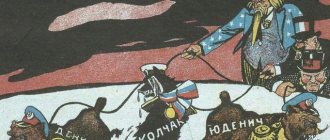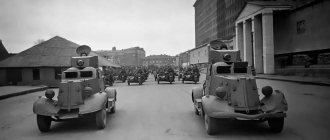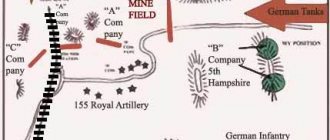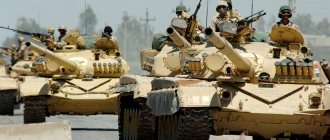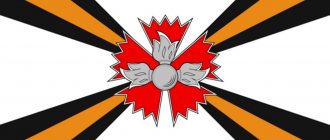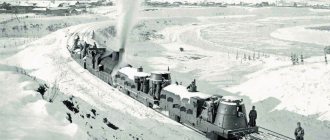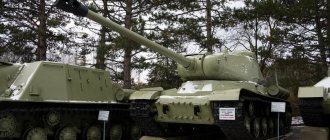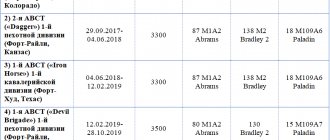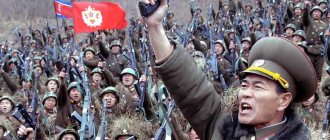Plans for Finnish strikes in Operation Barbarossa[1].
The territories ceded to the USSR after the Winter War are highlighted in color. The map does not indicate the German attack carried out from Finland on Murmansk. Soviet-Finnish war 1941-1944
- part of the Great Patriotic War;
in Finland it is known as the Continuation War
(Finnish:
Jatkosota
). The war lasted from June 25, 1941 to September 19, 1944 (the date of the armistice; hostilities actually stopped on September 5); The peace treaty was signed on February 10, 1947 in Paris.
Content
- 1 Background
- 2 Brief description
- 3 Results of the Soviet-Finnish war
- 4 Myths 4.1 Myth: The war began with an attack by the USSR
- 4.2 Myth: Finland stopped advancing on the old border
- 4.3 Myth: Finland was only at war with the USSR
- 4.4 Myth: Finland fought a separate war from Germany
- 4.5 Myth: The USSR failed to win
Sources[edit | edit code]
- A. B. Shirokorad, Northern Wars of Russia. M.: AST; Mn.: Harvest, 2001. - 848 with ISBN 5-17-009849-9 [15]
- Memoirs of Mannerheim [16]
- Meltyukhov M.I. “Stalin’s missed chance. The Soviet Union and the struggle for Europe: 1939-1941" [17]
- Section “USSR-FINLAND” on the website https://around.spb.ru: [18]
- From the letters of the Finnish politician Väine Vojonmaa
- Solovyov L. K., Silin A. F. From “Jaguar” “THE BLUE FOX” LOSES HIS CLAWS ISBN 5-88604-010-2
| The original source of this article was recognized as a “good article” by the Russian section of Wikipedia. |
When writing this article, materials from the “Soviet-Finnish War of 1941-1944” page of Russian Wikipedia were used.
Background
According to the 1920 treaty, the ice-free port of Pechenga (Petsamo) (highlighted in red) went to Finland, and Finland renounced territorial claims to territories in Karelia (highlighted in green).
After the emergence of an independent state, the ruling elite of Finland for a quarter of a century dreamed of expanding the country's territory to the White Sea and the White Sea Isthmus. The war of 1941–1944 was the fourth and final war between Russia (USSR) and the sovereign Finland that emerged from the collapse of the Russian Empire in the 20th century.
The first Soviet-Finnish war took place in 1918-1920. This war took place on Russian territory, and Finland acted as the aggressor in it. As a result, under the Treaty of Tartu, Finland annexed the strategically important[3] territory in the Pechenga region that had belonged to Russia since the end of the 16th century[2].
The Second Soviet-Finnish War (1921-1922) went on in 1921-1922 without a declaration of war. It consisted of a Finnish-led rebellion in territories that Finland wanted but failed to annex during the first war, followed by an invasion by Finnish "volunteers". After the defeat of the rebellion, the massive participation of career officers of the Finnish army in the hostilities was proven.
The third Soviet-Finnish war took place in 1939-1940. In the context of the impending world war, the USSR, since 1938, had been conducting multi-stage secret negotiations with Finland in order to improve the defense capability of Leningrad, which was geographically in an extremely vulnerable position (and in the event of a surprise attack, it would inevitably be lost by the Soviet side in the first days of the war). At the final stage of negotiations, Soviet proposals mainly boiled down to an exchange of territory. Finland had to move the border from Leningrad by 90 km and cede a number of islands that were strategically important for defense. In exchange, Finland was offered twice the territory in Karelia, the same territory that the Finns unsuccessfully tried to capture in the first two wars. After the final refusal[4][5] of Finland, the so-called “Winter War” began (the reason for it was the so-called “Maynila Incident” - artillery shelling of our territory by the Finns, which was neither the first nor the most massive, but only became “ the last straw"; there is, however, a point of view according to which this shelling was actually carried out from Soviet territory and was a provocation of the USSR). The Soviet leadership underestimated the combat capability of the Finnish army (in particular, the presence of a powerful line of fortifications on the Karelian Isthmus - the so-called “Mannerheim Line”) and poorly planned the operation. As a result, the war dragged on, and the Red Army suffered heavy losses at the initial stage of the war. However, having pulled up reserves and regrouped, the Soviet troops successfully broke through the Finnish defenses and entered the operational space. In this situation, the Finnish army was obviously unable to contain the Soviet army, and the Finnish government hastened to begin peace negotiations. Thus, the USSR achieved all the stated goals of the war and even more - since after the victory the Finnish border was moved to the northwest much further than was originally proposed to the Finns, and without any compensation. Through the efforts of anti-Russian Western diplomats, the USSR was expelled from the League of Nations following the results of the Soviet-Finnish War, but this only meant the political death of the organization itself - it no longer played any role in politics and was dissolved in 1946.
Thus, in two of the three previous wars, Finland acted as an aggressor, and the wrong political decision of 1939, instead of increasing the country’s territory, led to its decrease. Finnish historians consider the fourth war to be a “continuation” of the third, although in fact it was a continuation of the first two.
Political events in 1941-1943[edit | edit code]
German soldiers in Rovaniemi, 1942.
By the end of August 1941, Finnish troops reached the entire length of the old border. The border crossing in September led to tensions in the army, government, parliament and society.[20]
International relations deteriorated, especially with Great Britain and Sweden, whose governments in May-June received assurances from Witting (the head of the Finnish Foreign Ministry) that Finland had absolutely no plans to conduct a joint military campaign with Germany. Finnish preparations were described as purely defensive.
In July, the British Commonwealth declared a blockade of Finland. On 31 July, the RAF launched an airstrike against German forces in the Petsamo sector.[21]
On September 11, Witting informed the US Ambassador to Finland, Arthur Schoenfield, that the offensive operation on the Karelian Isthmus had been stopped at the old (pre-Winter War) border and that “under no circumstances” would Finland take part in the offensive operation against Leningrad, but would maintain a static defense in awaiting a political resolution of the conflict. Witting drew Schonfield's attention, however, that Germany should not find out about this conversation.
On September 22, the British government, under the threat of war, demanded that the Finnish government clear Finnish territory of German troops and withdraw Finnish troops from eastern Karelia to the 1939 border. War was declared by the mother country on December 5, and by the dominions on December 6, 1941.
By the end of 1941, the front line had finally stabilized. German failures near Moscow showed the Finns that the war would not end soon, which led to a drop in morale in the army. At the same time, it was not possible to exit the war through a separate peace with the USSR, since such a step would lead to aggravation of relations with Germany and the possible occupation of Finland. Finland is carrying out a partial demobilization of the army and is going on the defensive at the achieved positions.
Finland began an active search for ways to conclude peace in February 1943, after the German defeat in the Battle of Stalingrad. On February 2, the remnants of the 6th German Army capitulated, and already on February 9, the top leadership of Finland organized a secret meeting of parliament, at which, in particular, it was stated:
The German forces are undoubtedly beginning to dry up... over the winter, Germany and its allies lost almost 60 divisions. It is unlikely that it will be possible to make up for such losses. The fate of our country has until now been associated with the victory of German weapons, but in connection with the development of the situation, it is better to get used to the possibility that we will once again be forced to sign the Moscow Peace Treaty. Finland does not yet have the freedom to pursue its own foreign policy and must therefore continue to fight.[22]
The development of events in Finland until the end of 1943 is schematically given below.
- On February 15, the Social Democrats issued a statement emphasizing that Finland has the right to withdraw from the war at a time it deems desirable and possible.
- On March 20, the US State Department officially offered its assistance in Finland's exit from the war. The proposal was rejected as premature.
- In March, Germany demanded that the Finns sign a formal commitment to a military alliance with Germany, under the threat of cutting off the supply of weapons and food. The Finns refuse. The German ambassador to Finland is being recalled.
- At the beginning of June, Germany stops supplies. The Finns still refuse to change their position. Deliveries are resumed at the end of the month without any conditions.
- At the end of June, on the initiative of Mannerheim, the Finnish battalion, formed from volunteers in the spring of 1941 (participated in hostilities against the USSR as part of the 5th SS Viking Panzer Division), was disbanded.
- In July, contacts between the Finns and the USSR began through the Soviet embassy in Sweden (headed at that time by Alexandra Kollontai)
- In the fall of 1943, 33 prominent Finnish citizens, including several members of parliament, sent a letter to the president wishing the government to take steps to make peace. The letter, known as the "Address of the Thirty-Three", was published in the Swedish press.
- At the beginning of November, the Social Democratic Party issued a new statement, which not only emphasized Finland's right to withdraw from the war at its own discretion, but also noted that this step should be taken without delay.
Short description
The war was justified by Finland’s desire to return the territories lost in 1940, but in negotiations with the Germans the Finns discussed the annexation of Soviet territories up to the White Sea, or more precisely to the “border of the three isthmuses” of Karelian, Olonetsky and White Sea [6][7][8]. For this purpose, Finland entered into an alliance with Nazi Germany and took its side. In 1941, the Finnish army managed to capture significant territories on the Karelian Isthmus and in Karelia (including the capital of Karelia, Petrozavodsk) and blockade Leningrad from the north. Subsequently, the front stabilized, and in 1944, as a result of a powerful offensive by the Soviet Army, Finnish troops on the Karelian Isthmus were defeated. The Finnish leadership, realizing the futility of further hostilities, broke off relations with Germany, ceased hostilities on September 5 and signed an armistice on September 19. Subsequently, the Finnish army participated in the war on the side of the anti-Hitler coalition (the so-called Lapland War).
War participants[edit | edit code]
Marshal Mannerheim and President Ryti inspect troops in Enso (now Svetogorsk).
06/04/1944. Great Britain declared war on Finland on December 5, 1941, but did not actively participate in the war, except for sending several Royal Air Force units to the Soviet-Finnish front. Great Britain also interned all Finnish citizens and ships within its reach and seized Finnish assets in the kingdom and dominions. Nazi Germany provided Finland with critical material support and maintained close military cooperation, which, however, often came down to the execution by the Finnish General Staff of the directives of the Wehrmacht High Command. The United States did not declare war on Finland, as well as on other German satellites, and Finland itself refrained from such a step. The United States broke off diplomatic relations with Finland at the request of the USSR only on June 30, 1944, but until this date provided the USSR with significant assistance, officially intended for use by the USSR in its war with Germany and its satellites.
Results of the Soviet-Finnish war
Bair Irincheev about the results of the Soviet-Finnish war
The Treaty of Paris consolidated the territorial gains of the USSR in 1940, in addition to which the USSR also transferred the city of Petsamo (Pechenga) - a Russian city that Finland annexed after the first Soviet-Finnish War, and leased territory in Porkkala for the creation of a Soviet naval bases. In addition, Finland pledged to pay large monetary compensation to the USSR, dissolve fascist organizations and prevent their re-establishment, conduct trials of war criminals, etc.; restrictions were imposed on the size and armament of the Finnish army and navy. In September 1990, using the unification of Germany as a pretext, Finland unilaterally declared that the military restrictions of the 1947 treaty (with the exception of the ban on nuclear weapons) were no longer valid for it. There was no reaction to this from the USSR.
During the war years, about 24 thousand people from the local population were thrown into Finnish concentration camps, of whom about 4 thousand died of starvation. Of the approximately 64 thousand Soviet prisoners of war who passed through Finnish camps, according to Finnish data, more than 18 thousand died, that is, at least 28%. The percentage of dead Soviet prisoners indicates the extremely difficult conditions of their detention in the camps. According to the NKVD, 16.3% of Finnish prisoners died in Soviet camps[9].
After the war, the Finnish leadership, abandoning anti-Soviet and revanchist policies, normalized relations with the USSR, which served the interests of Finland itself: in particular, the Soviet Union in 1955 prematurely abandoned the lease of the naval base in Porkkala and withdrew its troops from Finnish territory; The USSR became one of Finland's most important trading partners.
People's Government of Finland
We have already mentioned that Soviet soldiers managed to establish contact with Otto Kuusinen, who later formed the people's government of Finland. This happened on December 1, 1939, on those lands that had already been captured by the USSR. At the same time, the Soviet leadership actively participated in its formation.
The people's government during the 1939 war consisted of:
- Foreign Minister and Chairman Otto Kuusinen.
- Defense Minister Axel Antil.
- Finance Minister Mauri Rosenberg.
- Minister of Internal Affairs Tuure Lehen.
- Minister of Education Inkeri Lehtinen.
- Minister of Agriculture Armas Eikia.
- Minister for Karelia Affairs Paavo Prokkonen.
The government was complete in all respects, but the Finnish people did not recognize it. Immediately after its formation (December 1), the government concluded an agreement with the Soviet Union on diplomatic relations. The next day a new document on mutual assistance was concluded. From this time on, Molotov tells the soldiers that the war is not over, because the Finns had a revolution and now need the help of the Soviet army. In fact, this was a good excuse to continue the conflict.
Myths
There are many myths associated with the fourth Soviet-Finnish war. Openly expressing sympathy for Hitler is considered indecent even among a significant part of Russophobes and liberals, so Finland, which allegedly waged a “just” war against the USSR and was a “victim” of Soviet “aggression,” became a convenient object for their veneration. This was greatly facilitated by the position of Finland itself, which both during the war and after it emphasized that this war was separate from the war waged by Hitler.
Myth: The war began with an attack by the USSR
The implementation of Plan Barbarossa began in the northern Baltic on the evening of June 21, when 7 German minelayers based in Finnish ports laid two minefields in the Gulf of Finland[10]. These minefields were eventually able to trap the Soviet Baltic Fleet in the eastern Gulf of Finland. Later that evening, German bombers, flying along the Gulf of Finland, mined Leningrad harbor, the Kronstadt roadstead and the Neva. On the way back, the planes refueled at the Finnish airfield in Utti[11].
On the morning of June 22, the Finnish landing force, under the cover of warships, crossed the border of territorial waters and began landing on the Åland Islands, which were a demilitarized zone. This landing violated the agreement between the USSR and Finland on the Åland Islands and was an act of aggression on the part of Finnish troops.
In the following days, the German naval and air forces did not stop operating against the USSR from the territory of Finland[12]. However, Finland did not allow the invasion of its own and German ground forces, waiting for the USSR to respond in order to declare war as a “victim of aggression.” On June 25, Soviet aviation attacked Finnish airfields where German aircraft were based. After this, Finland declared that it was in a state of war with the USSR, and on June 29, the invasion of Finnish troops into the territory of the USSR began.
Myth: Finland has stopped advancing on the old border
The limit of the maximum advance of the Finnish army during the war of 1941-1944.
The map also shows the borders before and after the Soviet-Finnish War of 1939-1940. In fact, the Finnish army stopped near the old border, which existed before 1940, only on the Karelian Isthmus near Leningrad (and did this not of its own free will, but because further advance was hampered by Soviet heavy artillery). In other directions, the Finns advanced far beyond this line, occupying territories that had never been part of Finland.
Myth: Finland was only at war with the USSR
In fact, in addition to the USSR, Great Britain, Australia, New Zealand, Canada, India, South Africa and Czechoslovakia were also at war with Finland. This is evidenced by the preamble of the 1947 peace treaty:
| The Union of Soviet Socialist Republics, the United Kingdom of Great Britain and Northern Ireland, Australia, the Belarusian Soviet Socialist Republic, Canada, Czechoslovakia, India, New Zealand, the Ukrainian Soviet Socialist Republic and the Union of South Africa, as states at war with Finland and actively participating in the war against enemy states in Europe with substantial military contingents, hereinafter referred to as the "Allied and Associated Powers" on the one hand, and Finland on the other... |
Myth: Finland fought a separate war from Germany
In fact, an agreement on joint military operations was signed between Finland and Germany, the combat plans of the parties were coordinated with each other. A joint Italian-Finnish-German flotilla operated on Lake Ladoga. Germany supplied Finland with a significant amount of military equipment.
The attack on Murmansk from the territory of Finland was launched by German troops with the participation of Finnish troops. German troops from Task Force Narva and aviation from the 1st and 5th Air Fleets, the 303rd Assault Gun Brigade and the 122nd Infantry Division participated in repelling the Soviet offensive in the summer of 1944.
The Finns indeed categorically refused the Germans' repeated proposals to storm Leningrad, which allowed the release of two Soviet divisions. However, the blockade of Leningrad without the participation of the Finnish army would have been impossible, and Finland bears responsibility for its consequences along with Germany.
In addition, even if Finland really waged an independent war simultaneously with Germany, this war could not help but help the Nazis, since it required the diversion of Soviet troops and other resources that could be used on other sectors of the front.
Myth: The USSR failed to win
The Battle of Tali-Ihantala at the end of June and beginning of July 1944 is interpreted by Finnish sources as a “defensive victory” for Finland, as a result of which Soviet troops were forced to go on the defensive. However, in reality, this can only be explained by the fact that this direction in the general course of the Great Patriotic War was clearly secondary (Finland is separated from Germany by the Baltic Sea), and the Soviet command simply considered it inappropriate to transfer additional forces to the Karelian Isthmus. If necessary, Finnish resistance could easily be broken.
This is evidenced by the fact that just two months after the “victory,” the Finnish leadership concluded a truce on Soviet terms, realizing the futility of further war.
The forces of the parties at the beginning of the war[edit | edit code]
In addition to the two Finnish armies, which were supposed to advance from the territory of Finland in the direction of Leningrad, a German-Finnish group of troops consisting of 5 German and 16 Finnish divisions, as well as 3 Finnish brigades, was supposed to advance from the territory of Northern Norway in the direction of Murmansk.
They were opposed by:
- on the Karelian Isthmus - the Soviet 23rd Army consisting of the 50th, 19th Corps and 10th Mechanized Corps, a total of 5 infantry, 1 motorized and 2 tank divisions;
- in Karelia - the 7th Army consisting of 4 infantry divisions;
- in the Murmansk region - the 14th Army and the 42nd Corps, a total of 5 infantry divisions (1 stationed in Arkhangelsk) and 1 tank division.
Additionally, Soviet troops numbered about 40 battalions, individual units and engineering units. Three infantry and one mechanized divisions were additionally stationed in Leningrad.
The Soviet Air Force units located along the Finnish border were not damaged by German airstrikes in the first days of the war, so by the beginning of the war the USSR could use about 750 Air Force aircraft against Finland and partly the Baltic Fleet aviation (about 700 aircraft). The Finnish Air Force consisted of about 300 aircraft.
Due to the unsuccessful start of the war with Germany for the USSR, the Soviet command was forced to withdraw some of the units deployed against Finland, in particular, the 10th Mechanized Corps with 2 tank divisions and the 237th Infantry Division from Karelia.
Notes
- Henrik Lunde. Finland's War of Choice: The Untidy Coalition of a Democracy and a Dictatorship in World War II. Casemate Publishers, 2011, p. 68.
- A deposit of nickel, a strategic raw material used by the Germans during World War II, was discovered on the territory. Pechenga is also an ice-free port with access to the Barents Sea.
- Leskinen, Jari & Juutilainen, Antti (toim.)
Talvisodan pikkujättiläinen. - Porvoo: WSOY, 1999. - ISBN 951-0-23536-9 - Siilasvuo, Ensio (toim.)
Talvisodan kronikka. — Jyväskylä: Gummerus, 1989. — ISBN 951-20-3446-8 - Baryshnikov N. And
chapter: Finnish bombers in the Leningrad zone // [Siege of Leningrad and Finland 1941–44. - Helsinki, 2002. - ISBN 952-5412-10-5 - Mauno Jokipia
Finland on the road to war. - Petrozavodsk: Karelia, 1999. - P. 145-146. — 370 s. — 1000 copies. — ISBN 5-7545-0735-6 - Proceedings of the VIII Soviet-Finnish Symposium of Historians: Petrozavodsk October 21-23, 1981. Officially, the goal of the war was to return the territory lost under the Moscow Peace Treaty of 1940.
In addition, the goal in wide circles was to seize territories east of the 1939 border in the event that Germany won the war . - Konasov V.B.
Finnish prisoners of war of the Second World War. Magazine "North" No. 11-12, 2002. Retrieved March 28, 2010. Archived from the original source on August 24, 2011. - Gunnar Åselius
, “The rise and fall of the Soviet Navy in the Baltic, 1921—1941,” page 224; Routledge, 2005; ISBN 0-7146-5540-6, 9780714655406 - M. Jokipia
Brotherhood in arms: from Barbarossa to Finland’s entry into the war. — Fragment from the book “Finland on the Road to War: A Study of Military Cooperation between Germany and Finland in 1940-1941.” Retrieved May 19, 2010. Archived from the original on August 22, 2011. - Mauno Jokipia
Finland on the road to war. - Petrozavodsk: Karelia, 1999. - P. 283-291. — 370 s. — 1000 copies. — ISBN 5-7545-0735-6
A look from the inside
The war with Finland lasted so long because there were many problems within the army. The battles were fought undisciplinedly and the command was very poor. Every second report or memo constantly explained the reasons for the failures. Historians even quote some:
- During the landing on Sayskari, a Soviet plane dropped five bombs that hit the destroyer Lenin.
- On December 1, they fired at the Ladoga flotilla twice with their own aircraft.
- When taking the island of Gogland, six Soviet detachments moved along it. Six Soviet planes immediately appeared, one of which fired a burst several times. Ten people were injured.
The equipment of the Soviet army was also far from ideal. For example, during the offensive in the Tulivara area, the rifle corps needed to bypass enemy fortifications, and for this two hundred pairs of skis were required. The plans were not destined to come true, because three thousand skis with broken bindings were received.
Replenishment of the 363rd Signal Battalion consisted of thirty broken down vehicles and five hundred men dressed in summer uniforms.
The 51st Corps Artillery Regiment came to replenish the Ninth Army. As a result, 65 trailers and 72 tractors were missing. 37 tractors arrived, of which only 9 were in good condition. Of the one hundred and fifty machines, only ninety could be used. Almost the entire composition was without winter uniform.
All these events provoked desertion. At the beginning of December, 430 people escaped from the 64th division.
Links
- Text of the 1947 peace treaty
- The myth of “peaceful” Finland. What prompted the USSR to start a war with Finland
| [ + ] The Great Patriotic War | |
| In culture | Music and songs about the Great Patriotic War • Films about the Great Patriotic War (including 28 Panfilovites and Litvyak) |
| Victory Day celebration | Essay: Why do we celebrate Victory Day • Immortal Regiment • Celebrating the 70th anniversary of the Victory (including the 2015 Parade) |
| Other | Cities of military glory • Hero Cities |
| [ [ + ]r> History of Russia | |
| Ancient Rus' | Causes of the crisis and collapse of Ancient Rus' |
| Moscow Rus' | Causes of the crisis of the Russian Kingdom |
| Russian empire | Defense of Neyshlot • Myths about the Russo-Japanese War • Essay: Well-forgotten lessons of the Russo-Japanese War • Russian genocide in Austria-Hungary • Causes of the crisis and collapse of the Russian Empire |
| Soviet Union | Red Army soldiers in Polish captivity • Genocide of Soviet prisoners of war • 28 Panfilovites • Myths about the Great Patriotic War • Soviet-Finnish War (1941-1944) • Red Army soldiers in Finnish captivity • Pros and cons of Soviet education • Essay: Why we celebrate Victory Day • Referendum results on the preservation of the USSR • The collapse of the USSR • The collapse of Soviet science |
| Modern Russia | Changes in the borders of modern Russia • Shooting at Ostankino • Reunification with Crimea • Immortal Regiment • 70th anniversary of the Victory (parade) • Russian military actions in Syria • State Duma elections (2016) • Presidential elections (2018) • Reform of the Russian Constitution (chronology , voting) • State Duma elections (2021) • The future of Russia |
Why so long?
The Russian-Finnish war of 1939-1940 was supposed to end in three weeks - this is what the Soviet leadership assumed. The plans were due to the fact that the Red Army had a numerical superiority. In reality, the conflict became protracted; the countries fought for four months. Why did this happen? There are several reasons for this:
- Poorly organized troops. This includes poor command performance and lack of coherence between different troops. Historians, when studying military documents, especially point out these shortcomings because there are many reports of one army firing at another.
- Poor provision. The army was in need on all counts. The battles were fought in the north, and this despite the fact that the temperature there did not rise above -30 degrees, and the soldiers did not have winter clothing.
- Underestimating the enemy. The Soviet Union planned to quickly defeat Finland and write off the war itself as a border conflict.
- Support from other countries. The Finns were supported by England, Hungary, Italy, and Sweden. Help consisted of weapons, planes, food, supplies. Sweden provided more assistance; it also acted as a mediator and transferred assistance from other states. During the Finnish War, the Soviet Union was supported only by Germany.
Stalin began to worry that the war was dragging on. He constantly reminded the military commanders that the whole world was watching the conflict. The Secretary General was not mistaken and demanded that order be restored among the troops and that all important problems be resolved. After a short time, this happened: already in February-March, Soviet troops forced the Finns to ask for peace.
Prisoners of war
Throughout the conflict, many prisoners were taken. During the war, it was said that 806 Finns and 5,393 Soviet soldiers were captured. Prisoners on both sides were divided into groups:
- Political leadership. It didn’t matter what rank the military man had, what mattered was his political affiliation.
- Junior officers.
- Officers. This included all persons equated to officers.
- National minorities.
- Privates.
- Defectors.
Most attention was paid to national minorities. The Finns treated them much better than the Russians. The relaxations, although insignificant, were there. When the war was over, both sides voluntarily handed over all prisoners of war, regardless of their belonging to a particular group.
